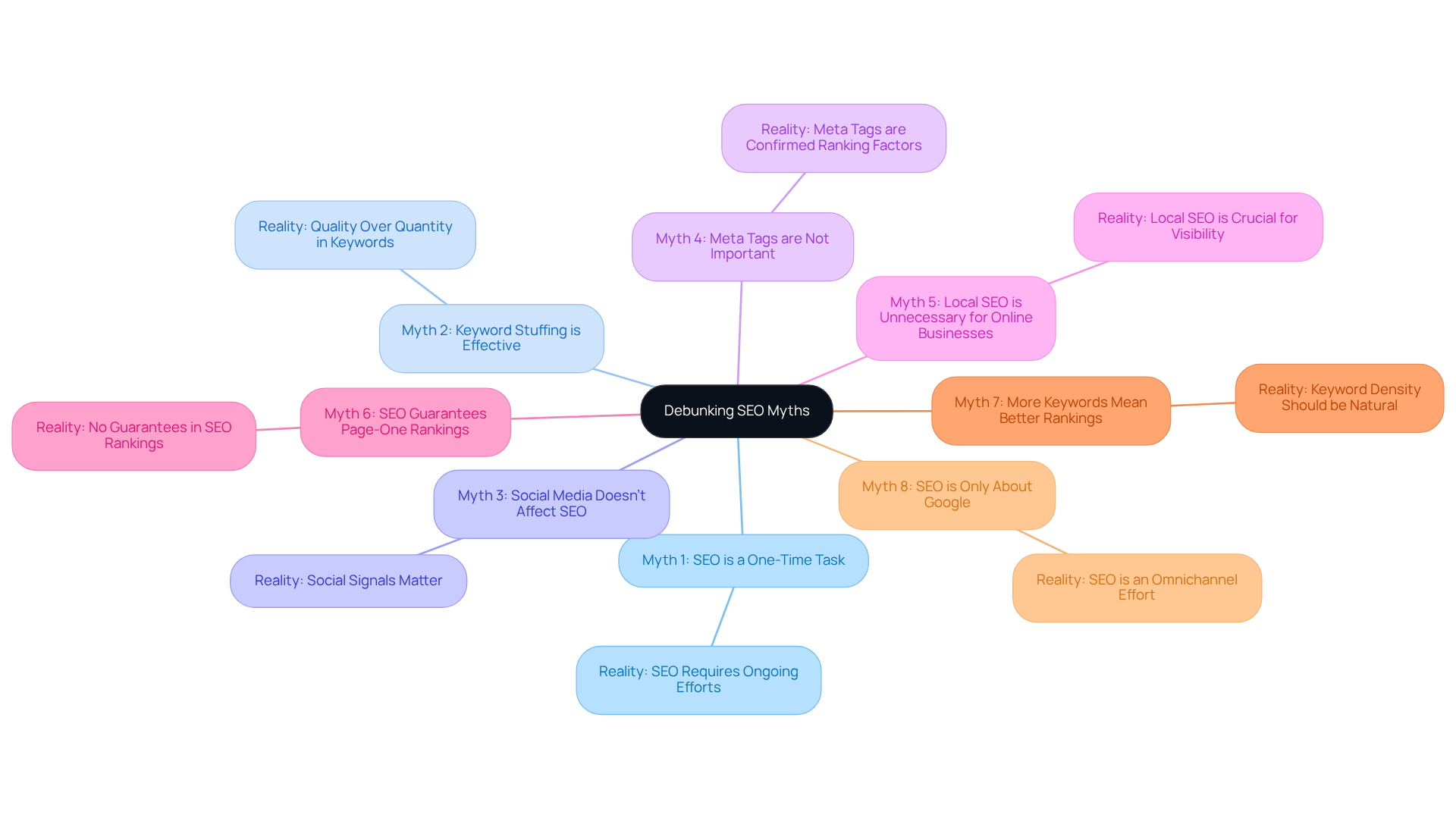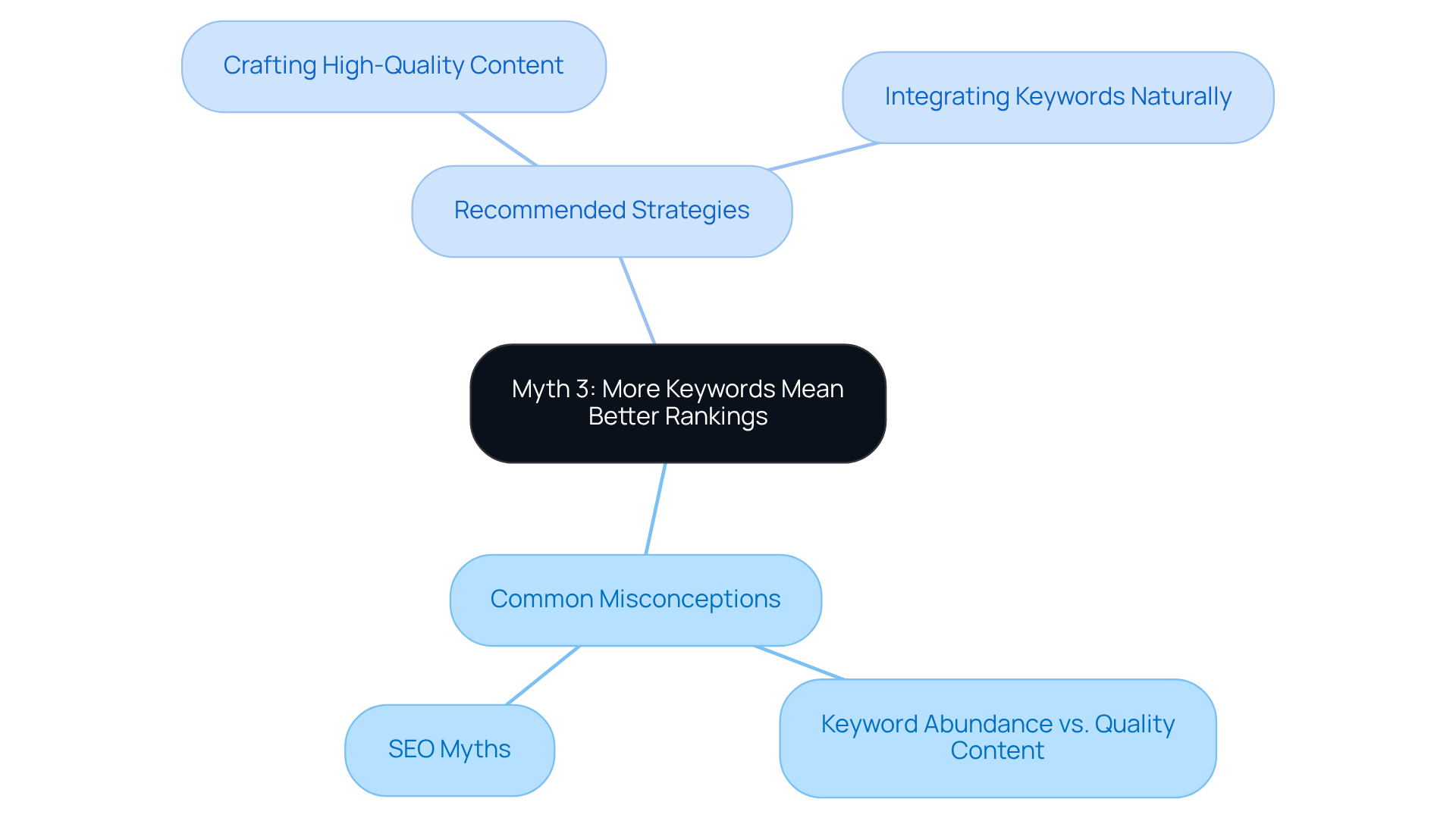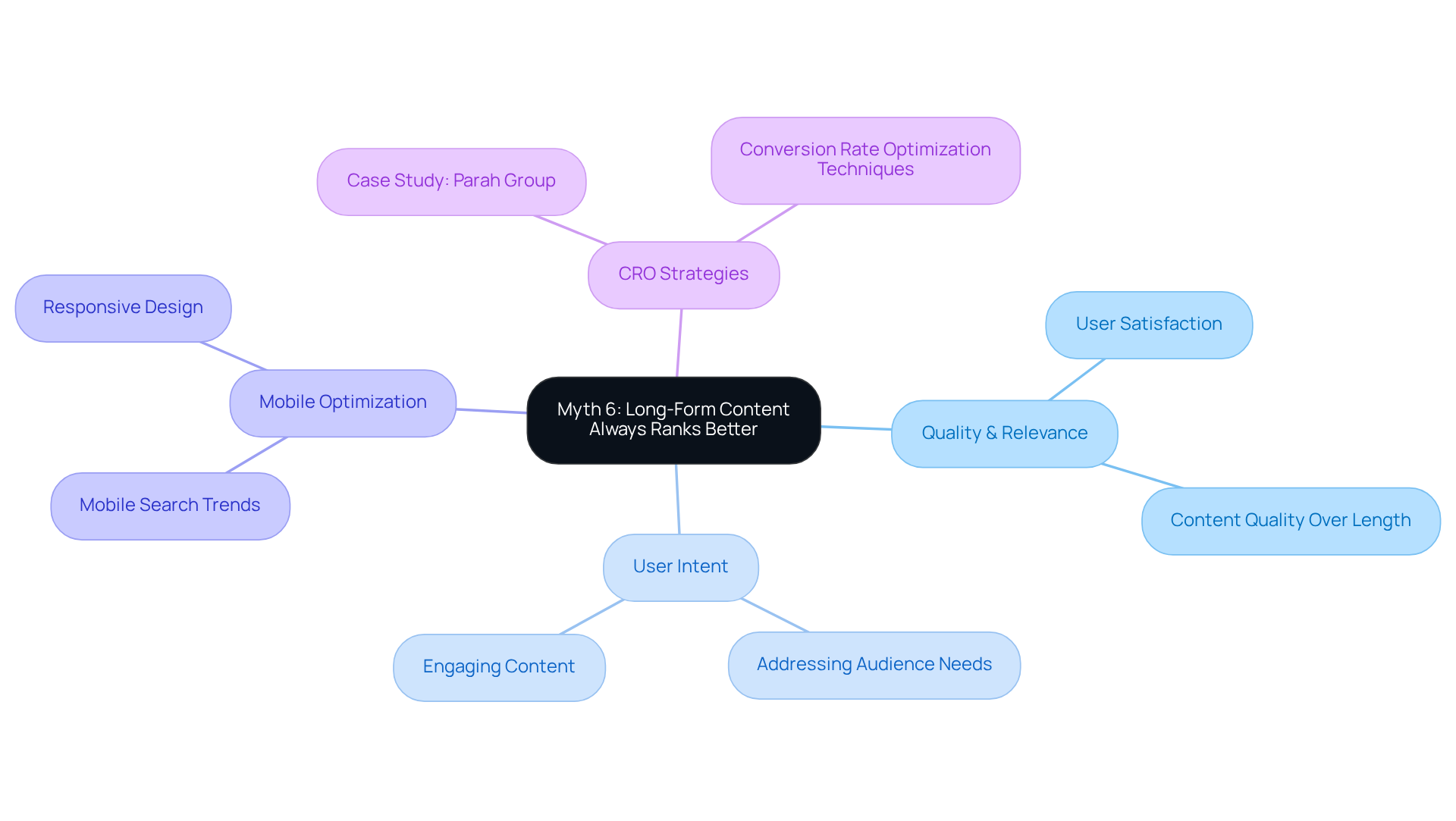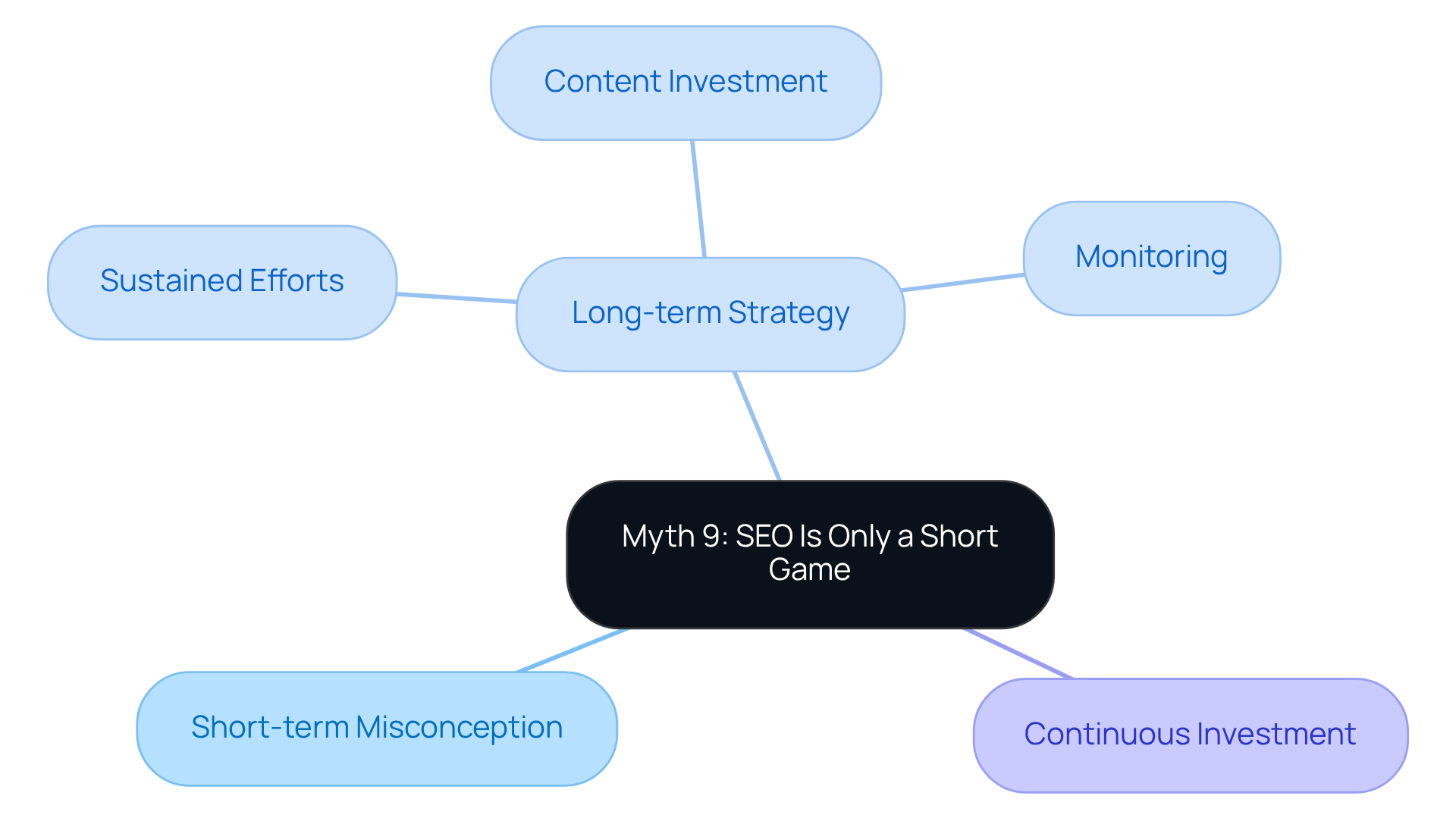
Overview
The article confronts the prevalent myths surrounding SEO that DTC brands must abandon, asserting that these misconceptions obstruct effective online strategies. By elucidating the realities of SEO—such as the necessity for continuous efforts, the significance of prioritizing quality over quantity in keywords and backlinks, and the critical role of local SEO—the article equips brands with the knowledge to implement informed practices. This empowerment not only enhances their visibility but also boosts profitability in an increasingly competitive digital landscape.
Introduction
Debunking myths surrounding search engine optimization (SEO) is paramount for direct-to-consumer (DTC) brands aiming to excel in a digital-first marketplace. Numerous companies succumb to misconceptions that impede their online visibility and profitability, erroneously believing that SEO is merely a one-time task or that immediate results are guaranteed. By investigating and dismantling these widespread myths, brands can align their strategies with effective practices that promote sustainable success.
What are the most detrimental myths about SEO that DTC brands must discard to flourish in an increasingly competitive landscape?
Parah Group: Debunking SEO Myths to Enhance Brand Growth
Parah Group acknowledges that many DTC companies encounter challenges because of the myths about SEO. By dispelling the myths about SEO, businesses can effectively align their strategies with proven practices that foster growth. This section delves into the myths about SEO and clarifies the realities, empowering companies to make informed decisions that enhance their online visibility and profitability.

Myth 1: SEO Is a One-Time Task
A common misconception among companies is related to the myths about SEO, as they believe it is a one-time task that can be completed and subsequently disregarded. In truth, there are many myths about SEO, as it is an ongoing commitment that requires consistent updates and adjustments to remain relevant.
Search engines frequently alter their algorithms—Google alone implements thousands of changes each year—while consumer behavior continues to shift. This dynamic landscape demands continuous monitoring and optimization of SEO strategies to maintain visibility and rankings.
Organizations with high SEO maturity are three times more likely to measure and report on a wider array of SEO metrics, highlighting the critical need to adapt to these changes. By 2025, 91% of organizations reported that SEO positively impacted their website performance and marketing objectives, reflecting a growing recognition among companies of the necessity for regular SEO updates.
For DTC companies, sustaining SEO relevance over time is crucial for capturing and retaining customer attention in an increasingly competitive digital marketplace. As noted by the Timmermann Group, "SEO isn’t dead. It’s simply becoming more sophisticated, strategic, and valuable for businesses that understand how to navigate the evolving search landscape.

Myth 2: SEO Drives Immediate Results
One of the common myths about SEO is the belief that it delivers instant results. In reality, SEO is a long-term strategy that often necessitates several months before significant outcomes are realized. Brands must prepare for a gradual increase in traffic and conversions as their SEO initiatives take root.
Statistics indicate that it typically takes 3 to 6 months for SEO strategies to yield noticeable results, influenced by factors such as domain authority and keyword optimization. Digital marketing specialists emphasize that effective SEO aims to dispel myths about SEO by focusing on establishing a memorable identity rather than merely being discovered online.
Thus, patience and persistence are vital for DTC companies aiming for sustainable growth through SEO, as this journey frequently results in compounding benefits over time.

Myth 3: More Keywords Mean Better Rankings
Many companies mistakenly believe in myths about SEO, thinking that simply using more keywords will automatically boost their rankings. However, the myths about SEO suggest that search engines prioritize mere keyword abundance over the quality and relevance of content. Instead of inundating their content with keywords, companies should concentrate on crafting high-quality, engaging material that naturally integrates relevant keywords. This strategy not only enhances SEO but also significantly improves the user experience.

Myth 4: More Backlinks Always Equal Better Rankings
A common misconception, which is one of the myths about SEO, is that an increase in backlinks will automatically enhance search engine rankings. In truth, the quality of backlinks is significantly more crucial than the myths about SEO imply regarding their quantity.
Direct-to-consumer (DTC) brands should prioritize acquiring links from credible and relevant sources, as these links carry greater weight in search engine algorithms. For example, a handful of high-quality backlinks can substantially boost a site's authority and visibility, often surpassing the impact of numerous low-quality links.
SEO experts, including Manick Bhan, emphasize that effective backlink strategies focus on fostering relationships with reputable sites, leading to enduring improvements in rankings. According to Backlinko, the top-ranking page on Google averages 3.8 times more backlinks than pages ranked 2-10, highlighting the strong correlation between high-quality backlinks and enhanced search performance.
Moreover, it is essential to acknowledge that only one in approximately 20 pages without backlinks receives traffic, which underscores the myths about SEO related to the critical role of backlinks for visibility. Therefore, DTC companies must adopt a strategic approach to link building, prioritizing the creation of high-quality content that naturally attracts backlinks.

Myth 5: Meta Tags Don't Matter Anymore
Contrary to the myths about SEO held by some brands, meta tags are essential for effective SEO. Title tags and meta descriptions serve as critical components that influence how search engines interpret and display content. When optimized effectively, these meta tags can significantly enhance click-through rates, a vital factor in driving traffic to websites.
For instance, well-crafted meta descriptions function as compelling mini advertisements, enticing users to click on the link. Data indicate that an engaging meta description can substantially increase the likelihood of users selecting a webpage from search results.
Direct-to-consumer (DTC) companies that prioritize the optimization of their meta tags—ensuring title tags remain within the ideal length of 55-64 characters and include relevant keywords—are poised to achieve enhanced visibility and elevated rankings in search engine results pages (SERPs).
As Chase Dean, an SEO Specialist, asserts, "Optimizing your meta tags can improve your web page’s ranking." Furthermore, companies must consider the role of canonical tags in managing duplicate content to counteract myths about SEO while further refining their SEO strategy.
To maximize the effectiveness of their meta tags, brands should consistently review and update them based on performance metrics.

Myth 6: Long-Form Content Always Ranks Better
A prevalent misconception is that lengthy articles consistently outperform shorter ones in search rankings, which is one of the common myths about SEO. In truth, the quality and relevance of content are far more critical determinants, despite the myths about SEO.
Direct-to-consumer (DTC) companies must prioritize crafting material that effectively addresses user intent and delivers genuine value, irrespective of its length. Engaging and informative content not only elevates user satisfaction but also plays a vital role in improving search rankings. By focusing on what truly resonates with their audience, brands can produce meaningful content that fosters both engagement and visibility.
Moreover, with mobile devices accounting for a significant portion of Google searches, optimizing content for user interaction across all platforms is imperative. Regularly revisiting and refreshing content guarantees its relevance and effectiveness, adapting to the evolving needs of the audience.
Furthermore, as evidenced by successful case studies from Parah Group, the implementation of strategic conversion rate optimization (CRO) can substantially enhance profitability. For example, a $30 million apparel company witnessed a 35% increase in conversion rates following the optimization of their homepage and the reduction of unnecessary distractions. Such transformations underscore the importance of integrating effective CRO strategies alongside SEO efforts to drive revenue growth and enhance overall performance.

Myth 7: Duplicate Content Will Get You Penalized
A prevalent concern among companies is the fear stemming from myths about SEO, particularly that duplicate material will incur penalties from search engines. However, Google has made it unequivocally clear that while myths about SEO suggest duplicate content can lead to direct penalties, it does not result in such penalties but rather indexing challenges.
Instead of fixating on minor repetitions, companies should prioritize the creation of distinctive and meaningful content. Effectively managing duplicate material is essential for maintaining SEO health, as it allows companies to focus on enhancing their overall strategy without unnecessary anxiety over trivial overlaps.
In fact, studies reveal that indexing issues associated with duplicate content can impact up to 30% of websites, underscoring the importance of proactively addressing this issue. To manage duplicate material effectively, DTC companies can implement strategies such as:
- Canonical tags, which signal to search engines the preferred version of a page
- Regularly reviewing their content to identify and rectify duplications
By adopting these measures, companies can bolster their SEO performance while mitigating the risks associated with duplicate content.

Myth 8: Local SEO Isn't Useful for Online-Only Businesses
Many online-only businesses mistakenly believe that local SEO is irrelevant to them. However, local SEO can significantly enhance visibility and attract customers from specific geographic areas. By improving visibility for local keywords and maintaining accurate local listings—such as NAP (Name, Address, Phone number) information—these brands can effectively engage with potential customers actively seeking their products or services nearby.
Ignoring local SEO can lead to missed opportunities, as approximately 78% of mobile local inquiries result in offline purchases. Furthermore, 88% of consumers who perform a local search on their smartphone interact with a store within 24 hours, underscoring the urgency and potential of local traffic.
Digital marketing experts assert that a strong Google Business Profile is crucial for boosting local visibility, with 90% of consumers depending on reviews to assess local businesses. Additionally, 49% of consumers utilize Facebook for local business information, and 76% use voice search weekly to find local businesses.
For DTC companies, implementing local SEO strategies is not merely advantageous; it is essential for attracting valuable traffic and increasing sales in an increasingly competitive market. Developing location-specific landing pages can further strengthen local SEO efforts, ensuring that online-only businesses stay relevant and visible to their target audience.

Myth 9: SEO Is Only a Short Game
The myths about SEO suggest that it is merely a short-term endeavor, which often leads brands to make impulsive decisions, neglecting the critical need for sustained efforts. SEO is fundamentally a long-term strategy that demands continuous investment in content, optimization, and monitoring. Brands that dedicate themselves to a long-term SEO strategy are far more likely to experience sustainable growth and enhanced rankings over time. It is imperative to recognize that SEO is a marathon, not a sprint, to achieve success.

Conclusion
Debunking the myths surrounding SEO is essential for DTC brands striving to excel in the digital landscape. Recognizing that SEO is not a one-time task but a continuous commitment can fundamentally transform a company's approach to online visibility. By embracing the realities of SEO, brands can align their strategies with practices that foster sustainable growth and enhance their overall online presence.
Throughout this article, several key misconceptions have been addressed, including the beliefs that:
- SEO delivers immediate results
- More keywords equate to better rankings
- Local SEO is irrelevant for online-only businesses
Each myth has been countered with compelling evidence and insights, underscoring the importance of quality content, strategic link building, and the ongoing optimization of SEO efforts. Moreover, the article highlights how local SEO can significantly benefit DTC brands by boosting visibility and attracting local customers.
Ultimately, recognizing and dispelling these SEO myths transcends merely improving rankings; it fosters a deeper understanding of how search engines operate and how consumers engage with online content. DTC brands are urged to invest in long-term SEO strategies that prioritize quality, relevance, and user experience, ensuring they remain competitive and visible in an ever-evolving digital marketplace. Embracing these insights will not only propel brand growth but also empower companies to navigate the complexities of SEO with confidence.
Frequently Asked Questions
What is the main purpose of the article about Parah Group and SEO myths?
The article aims to debunk common myths about SEO that hinder DTC companies from effectively aligning their strategies with proven practices, ultimately enhancing their brand growth and online visibility.
Is SEO a one-time task?
No, SEO is not a one-time task. It requires ongoing commitment, continuous updates, and adjustments to remain relevant due to frequent changes in search engine algorithms and shifting consumer behavior.
How often do search engines change their algorithms?
Search engines, particularly Google, implement thousands of changes to their algorithms each year, necessitating consistent monitoring and optimization of SEO strategies.
How does SEO maturity impact a company's performance?
Organizations with high SEO maturity are three times more likely to measure and report on a wider array of SEO metrics, which is critical for adapting to changes and enhancing website performance.
What is the expected timeline for seeing results from SEO efforts?
SEO is a long-term strategy that typically takes 3 to 6 months to yield noticeable results, influenced by factors such as domain authority and keyword optimization.
What should brands focus on when implementing SEO strategies?
Brands should focus on establishing a memorable identity rather than solely aiming to be discovered online, as effective SEO emphasizes long-term growth and brand recognition.
What is the importance of patience and persistence in SEO?
Patience and persistence are vital for DTC companies, as the journey of implementing SEO strategies often results in compounding benefits over time, leading to sustainable growth.
FAQs











